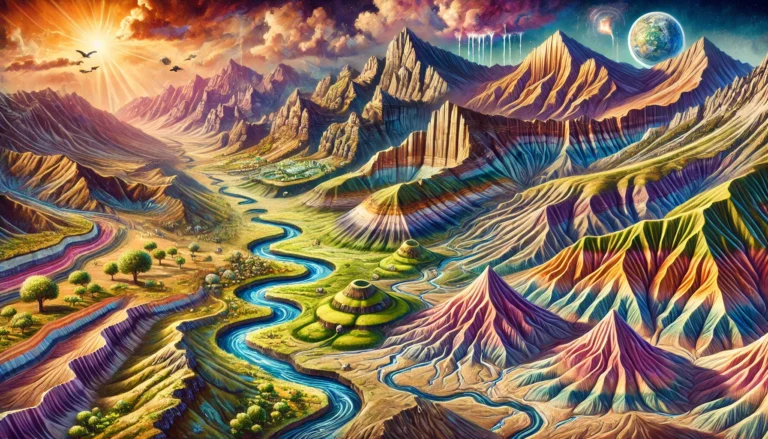Coral Reef Relief Features
Now, let’s understand different types of coral reefs, understanding their formation and characteristics.
But before that you should watch this video before moving ahead, since it will give you a visual idea about formation of these relief features: ▶️Birth of an Atoll
Fringing Reefs

Picture yourself standing on a beach, looking out at the sea. Just a short swim away, you notice an underwater ridge running parallel to the shore—this is a fringing reef. It is the simplest and most common type of coral reef, growing directly from the coastline.
- Structurally, a fringing reef extends outward from the shore like a submerged platform.
- The side facing the open sea is steep and vertical, acting like a protective barrier against strong ocean waves, while the landward side has a gentle slope.
- The top surface of the reef is not smooth—it’s rugged and corrugated, much like an ancient stone fortress weathered by time.
- In some places, a shallow lagoon, also called a boat channel, forms between the reef and the land, allowing small boats to pass.
These reefs are like the first line of defense for coastal regions, protecting them from erosion and storm surges.
Barrier Reefs
Now, let’s venture further into the sea, leaving the coastline behind. As you sail ahead, a vast stretch of shallow, turquoise waters suddenly appears, separated from the mainland by a deep, wide lagoon. This is a barrier reef—a grander and more complex version of a fringing reef.
- Unlike fringing reefs, barrier reefs are not directly attached to the land but run parallel to the coastline, separated by an expansive lagoon.
- They form the largest type of coral reef system, stretching for hundreds of kilometers.
- The depth at the base of a barrier reef can sometimes exceed what is typically required for coral growth, leading scientists to believe that these reefs formed due to subsidence (gradual sinking of land).
- The most famous example is the Great Barrier Reef off the east coast of Australia—the largest and most spectacular coral reef system in the world.
Barrier reefs serve as offshore fortresses, shielding coastal regions from the full force of ocean waves while creating rich marine habitats in their lagoons.
What is a Lagoon?
A lagoon is a shallow body of water separated from a larger water body (like an ocean or sea) by a barrier such as sandbanks, coral reefs, or barrier islands. Lagoons are typically found along coastlines and can be either saltwater, brackish, or freshwater, depending on their connection to the ocean.
There are two main types of lagoons:
- Coastal Lagoons – Formed when a sandbar or barrier island encloses a shallow body of seawater.
- Atoll Lagoons – Found within coral atolls, formed when corals grow around a sinking volcanic island, leaving behind a central lagoon.
Atolls
Now, imagine you are in the middle of the vast ocean, far from any continental landmass. As you dive down, you see a circular ring of coral reefs enclosing a lagoon—this is an atoll, one of nature’s most fascinating formations.
- Atolls typically form around submerged volcanic islands. Over time, as the island sinks due to geological processes, the surrounding coral structure continues to grow upward, eventually forming a ring-shaped reef enclosing a lagoon.
- Atolls are commonly found in the Indian Ocean and South Pacific, with famous examples including the Maldives and Lakshadweep.

Atolls can be classified into three types:
- True Atoll – A circular reef enclosing a shallow lagoon, but without any central island.
- Island Atoll – A reef ring surrounds an island in the center.
- Coral Island – Over time, deposition by marine waves turns parts of the atoll into land, creating small islands.

Atolls are like floating necklaces in the ocean, hosting unique ecosystems and supporting island communities.
Patch Reefs
On our final stop, imagine looking down from a boat into the clear waters of a continental shelf. You notice small, scattered coral formations rising from the seabed—these are patch reefs.
- Patch reefs are isolated coral formations that develop in deeper waters, often between fringing reefs and barrier reefs.
- They vary in size and do not necessarily reach the water’s surface, making them less visible than other reef types.
Think of patch reefs as independent coral outposts, scattered across the ocean floor, adding to the complexity of marine ecosystems.
Final Thoughts
Coral reefs are not just underwater landscapes; they are living ecosystems, sculpted by nature over millennia. From the coast-hugging fringing reefs to the mighty barrier reefs, from ring-like atolls to hidden patch reefs, each type plays a unique role in marine biodiversity and coastal protection.
Understanding these reef types helps us appreciate their importance and underscores the need for their conservation. After all, these silent architects of the sea are not just geological wonders—they are vital to the health of our planet.





